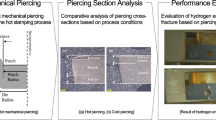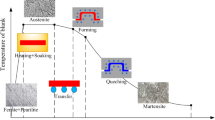Abstract
The increasing demand for lightweight vehicles, while ensuring collision safety, has led to the growing utilization of high-strength steel sheets. Accordingly, the hot stamping process, which involves heating the material and shaping it in a die while simultaneously cooling it, has gained significant attention. However, the inclusion of heating and cooling processes in the hot stamping engineering presents competitive disadvantages in terms of cost. As a result, numerous studies are being carried out to overcome these challenges and improve productivity. In particular, the sidewall areas of the vehicle body parts, which thin out during the stamping process, can experience a reduced cooling rate compared to other areas. To counteract the potential risk of a relative decrease in strength in these areas, extending the pressurization time of the press becomes necessary. In this study, by introducing groove patterns on the surface of the die used in the hot stamping forming and cooling processes, it was investigated how to enhance the cooling rate of the sidewall of the vehicle part without necessitating additional press dwell time. Using this approach, it was possible to achieve a strength of over 1.6 GPa and a dimensional accuracy of -0.06 mm within a short in-die quenching time of 6 s.














Similar content being viewed by others
References
Merklein M, Lechler J, Stoehr T (2009) Investigations on the thermal behavior of ultra high strength boron manganese steels within hot stamping. Int J Mater Form 2:259–262. https://doi.org/10.1007/s12289-009-0505-x
Merklein M, Lechler J, Geiger M (2006) Characterisation of the flow properties of the quenchenable ultra high strength steel 22MnB5. CIRP Ann 55:229–232. https://doi.org/10.1016/s0007-8506(07)60404-1
Li X, Nam K-M (2022) Environmental regulations as industrial policy: vehicle emission standards and automotive industry performance. Environ Sci Policy 131:68–83. https://doi.org/10.1016/j.envsci.2022.01.015
Ravina M, Bianco I, Ruffino B et al (2023) Hard-to-recycle plastics in the automotive sector: Economic, environmental and technical analyses of possible actions. J Clean Prod 394:136227. https://doi.org/10.1016/j.jclepro.2023.136227
Kumar S, Singhai M, Desai R et al (2015) Development of advanced high strength steel for improved vehicle safety, fuel efficiency and CO2 emission. J Inst Eng India Ser D 97:153–158. https://doi.org/10.1007/s40033-015-0100-x
Chang Y, Meng Z, Ying L et al (2011) Influence of hot press forming techniques on properties of vehicle high strength steels. J Iron Steel Res Int 18:59–63. https://doi.org/10.1016/s1006-706x(11)60066-6
Chongthairungruang B, Uthaisangsuk V, Suranuntchai S, Jirathearanat S (2013) Springback prediction in sheet metal forming of high strength steels. Mater Des 50:253–266. https://doi.org/10.1016/j.matdes.2013.02.060
Mertin C, Stellmacher T, Schmitz R, Hirt G (2019) Enhanced springback prediction for bending of high-strength spring steel using material data from an inverse modelling approach. Procedia Manuf 29:153–160. https://doi.org/10.1016/j.promfg.2019.02.120
Yang F, Veljkovic M, Liu Y (2020) Ductile damage model calibration for high-strength structural steels. Constr Build Mater 263:120632. https://doi.org/10.1016/j.conbuildmat.2020.120632
Yan R, Xin H, Veljkovic M (2021) Ductile fracture simulation of cold-formed high strength steel using GTN damage model. J Constr Steel Res 184:106832. https://doi.org/10.1016/j.jcsr.2021.106832
Li H, Wu X, Li G, Zhou D (2020) Chipping damage of die for trimming advanced high-strength steel sheet: evaluation and analysis. J Mater Process Technol 285:116787. https://doi.org/10.1016/j.jmatprotec.2020.116787
Zhang W, Xu X, Liu Y et al (2021) High-strength cold-formed steel framed shear wall with steel sheet sheathing. Thin-Walled Struct 162:107584. https://doi.org/10.1016/j.tws.2021.107584
Abe Y, Ohmi T, Mori K, Masuda T (2014) Improvement of formability in deep drawing of ultra-high strength steel sheets by coating of die. J Mater Process Technol 214:1838–1843. https://doi.org/10.1016/j.jmatprotec.2014.03.023
Kharchenko V, Katok O, Sereda A et al (2022) Determination of strength characteristics of high-strength sheet steels by hardness and instrumented indentation. Procedia Struct Integr 36:277–283. https://doi.org/10.1016/j.prostr.2022.01.035
Ahn K, Jeong Y, Yoon J (2019) Thermo-mechanical constitutive equation of 22MnB5 steel sheet for hot press forming process. Int J Precis Eng Manuf 20:663–672. https://doi.org/10.1007/s12541-019-00033-z
Yoon SC, Kim DH (2013) Analysis of phase transformation and temperature history during hot stamping using the finite element method. Trans Mater Process 22:123–132. https://doi.org/10.5228/kstp.2013.22.3.123
Kim HY, Park JK, Lee M-G (2013) Phase transformation-based finite element modeling to predict strength and deformation of press-hardened tubular automotive part. Int J Adv Manuf Technol 70:1787–1801. https://doi.org/10.1007/s00170-013-5424-9
Pan H, Wei C, Yu W et al (2022) Achieving excellent strength–ductility combination by cyclic quenching treatment in 22MnB5 steel. J Mater Eng Perform 31:6659–6663. https://doi.org/10.1007/s11665-022-06737-0
Deng L, Mozgovoy S, Hardell J et al (2016) Numerical Study of contact conditions in press hardening for tool wear simulation. Int J Mater Form 10:717–727. https://doi.org/10.1007/s12289-016-1314-7
Lim W-S, Choi H-S, Ahn S, Kim B-M (2013) Cooling channel design of hot stamping tools for uniform high-strength components in hot stamping process. Int J Adv Manuf Technol 70:1189–1203. https://doi.org/10.1007/s00170-013-5331-0
Ganapathy M, Li N, Lin J, Bhattacharjee D (2017) Investigation of a new hot stamping process with improved formability and productivity. Procedia Eng 207:771–776. https://doi.org/10.1016/j.proeng.2017.10.827
Ou H, Zhang X, Xu J et al (2018) Mechanical properties and microstructure of high-strength steel controlled by hot stamping process. J Mater Eng Perform 27:4025–4035. https://doi.org/10.1007/s11665-018-3290-1
Ganapathy M, Li N, Lin J et al (2019) Experimental investigation of a new low-temperature hot stamping process for boron steels. Int J Adv Manuf Technol 105:669–682. https://doi.org/10.1007/s00170-019-04172-5
Abdollahpoor A, Chen X, Pereira MP et al (2016) Sensitivity of the final properties of tailored hot stamping components to the process and material parameters. J Mater Process Technol 228:125–136. https://doi.org/10.1016/j.jmatprotec.2014.11.033
Lee I-K, Lee S-Y, Kim B-M, Lee S-K (2017) Development of concurrent stamping-piercing trimless hot stamping process. J Mech Sci Technol 31:1885–1891. https://doi.org/10.1007/s12206-017-0336-5
Zhang P, Zhu L, Luo S, Luo J (2019) Hot stamping forming and finite element simulation of USIBOR1500 high-strength steel. Int J Adv Manuf Technol 103:3187–3197. https://doi.org/10.1007/s00170-019-03727-w
Vlasov AV (2016) Thermomechanical fatigue of dies for hot stamping. Steel Transl 46:356–360. https://doi.org/10.3103/s0967091216050156
Yun S, Kwon J, Cho W et al (2020) Performance improvement of hot stamping die for patchwork blank using mixed cooling channel designs with straight and conformal channels. Appl Therm Eng 165:114562. https://doi.org/10.1016/j.applthermaleng.2019.114562
Neugebauer R, Altan T, Geiger M et al (2006) Sheet metal forming at elevated temperatures. CIRP Ann 55:793–816. https://doi.org/10.1016/j.cirp.2006.10.008
Muvunzi R, Hagedorn-Hansen D, Matope S et al (2020) Industry case study: process chain for manufacturing of a large hybrid hot stamping tool with conformal cooling channels. Int J Adv Manuf Technol 110:1723–1730. https://doi.org/10.1007/s00170-020-05992-6
Chen L, Chen W, Xu F et al (2019) A pre-design method for drilled cooling pipes in hot stamping tool based on pipe parameter window. Int J Adv Manuf Technol 103:891–900. https://doi.org/10.1007/s00170-019-03587-4
Maeno T, Mori K-I, Fujimoto M (2015) Improvements in productivity and formability by water and die quenching in hot stamping of ultra-high strength steel parts. CIRP Ann 64:281–284. https://doi.org/10.1016/j.cirp.2015.04.128
Narayanasamy PS, Singh AK, Narasimhan K (2020) Effect of cooling system in hot stamping process. IOP Conf Ser: Mater Sci Eng 967:012059. https://doi.org/10.1088/1757-899x/967/1/012059
Ota E, Yogo Y, Iwata N, Nishigaki H (2019) CAE-based process design for improving formability in hot stamping with partial cooling. J Mater Process Technol 263:198–206. https://doi.org/10.1016/j.jmatprotec.2018.08.021
Park JM, Park KJ, Kong JY et al (2023) Development of rapid die cooling technology using the groove pressing method in hot stamping process. IOP Conf Ser: Mater Sci Eng 1284:012011. https://doi.org/10.1088/1757-899X/1284/1/012011
Gu Z, Lü M, Lu G et al (2015) Effect of contact pressure during quenching on microstructures and mechanical properties of hot-stamping parts. J Iron Steel Res Int 22:1138–1143. https://doi.org/10.1016/s1006-706x(15)30124-2
Wang M, Zhang C, Xiao H, Li B (2016) Inverse evaluation of equivalent contact heat transfer coefficient in hot stamping of boron steel. Int J Adv Manuf Technol 87:2925–2932. https://doi.org/10.1007/s00170-016-8678-1
Fan X, He Z, Zhou W, Yuan S (2016) Formability and strengthening mechanism of solution treated Al–Mg–Si alloy sheet under hot stamping conditions. J Mater Process Technol 228:179–185. https://doi.org/10.1016/j.jmatprotec.2015.10.016
Wen S, Chen Z, Qu S et al (2022) Investigations on the interfacial heat transfer coefficient during hot stamping of ultra-high strength steel with Al-Si coating. Int J Heat Mass Transf 189:122739. https://doi.org/10.1016/j.ijheatmasstransfer.2022.122739
Markham SK, Mani A, Korsakova EA et al (2020) Polarisation changes in guided infrared thermography using silver halide poly-crystalline mid-infrared fibre bundle. J Therm Anal Calorim 142:1115–1122. https://doi.org/10.1007/s10973-020-10018-0
Standard test methods for tension testing of metallic materials [metric] In: E8M. https://www.astm.org/e0008m-00a.html
Zheng Q, Aoyama T, Shimizu T, Yang M (2014) Experimental and numerical analysis of springback behavior under elevated temperatures in micro bending assisted by resistance heating. Procedia Eng 81:1481–1486. https://doi.org/10.1016/j.proeng.2014.10.177
Löbbe C, Hoppe C, Becker C, Tekkaya AE (2015) Closed loop springback control in progressive die bending by induction heating. Int J Precis Eng Manuf 16:2441–2449. https://doi.org/10.1007/s12541-015-0314-8
Oldenburg M, Hardell J, Casellas D (2019) Hot sheet metal forming of high-performance steel, CHS2 7th international conference: 2019, Luleå, Sweden: Proceedings. Verlag Wissenschaftliche Scripten, Auerbach/Vogtl
Inal K, Levesque J, Worswick M, Butcher C (2023) NUMISHEET 2022: Proceedings of the 12th international conference and workshop on numerical simulation of 3D sheet metal forming processes. Springer, Cham
Author information
Authors and Affiliations
Contributions
Jea Myoung Park: Writing – Original Draft, Formal analysis, Conceptualization. Je Youl Kong: Methodology, Investigation. Kye Jeong Park: Investigation, Formal analysis. Jin Ho Rhee: Investigation, Data Curation. Seung Chae Yoon: Writing – Review & Editing, Methodology, Supervision. Joo Sik Hyun: Investigation. All authors discussed the results and commented on the manuscript.
Corresponding author
Ethics declarations
Conflict of interests
The authors declare no conflict of interest.
Additional information
Publisher’s Note
Springer Nature remains neutral with regard to jurisdictional claims in published maps and institutional affiliations.
Rights and permissions
Springer Nature or its licensor (e.g. a society or other partner) holds exclusive rights to this article under a publishing agreement with the author(s) or other rightsholder(s); author self-archiving of the accepted manuscript version of this article is solely governed by the terms of such publishing agreement and applicable law.
About this article
Cite this article
Park, J.M., Kong, J.Y., Park, K.J. et al. Analysis of high strength characteristics of aluminized quenchable boron steel (22MnB5) using groove pattern on the hot stamping die surface. Int J Adv Manuf Technol (2024). https://doi.org/10.1007/s00170-024-13650-4
Received:
Accepted:
Published:
DOI: https://doi.org/10.1007/s00170-024-13650-4




